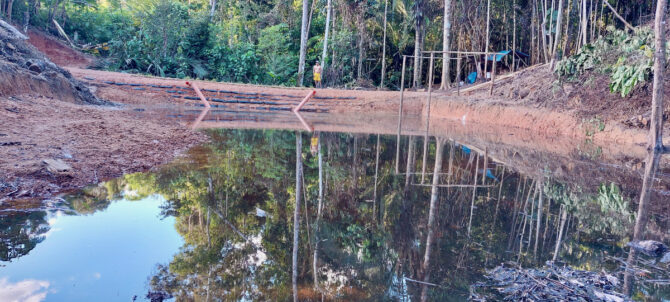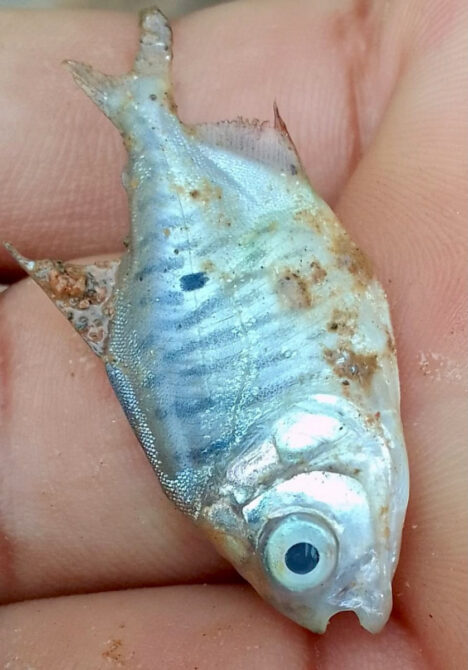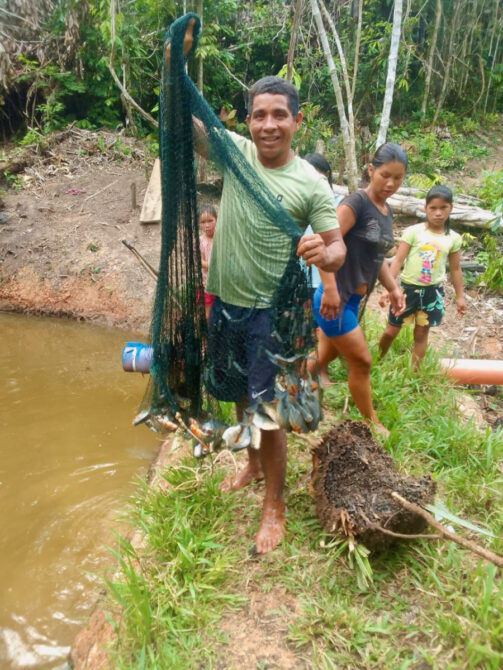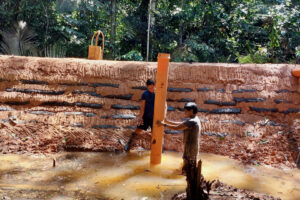
Acaté and Matsés communities launch a large scale initiative for integrated aquatic ecosystems to support food security, sustainable income opportunities, and women’s empowerment –
Before first contact with missionaries in 1969, every three years or so the Matsés moved their settlements to a new locality where animal game was more abundant. This abundance of game was complemented well by the Matsés’ starch-rich, but protein-poor, polyculture-swidden production. The swidden agriculture of the Matsés is perfectly adapted to their pre-contact semi-nomadic lifestyle, but due to their recent change to a sedentary settlement pattern with fixed communities, several challenges and deficiencies have arisen. Namely, these are 1) a shortage of protein, for which children are most impacted 2) the inevitable consequence that swiddens are constantly made further from the village, requiring women to transport the harvest on their backs long distances. 3) to access areas for hunting to provide protein for their families, Matsés hunters have to travel out farther and farther upriver to access game, requiring fuel and drawing families further into the cash economy with few economic opportunities to support it. As a result, in fixed settlements of present day Matsés communities, there is growing internal tension and competition over areas suitable for swiddens as well as the hunting and fishing grounds.
Aquaculture is the cultivation of fish, aquatic animals, or aquatic plants/algae in a controlled environment, sometimes called aquafarming. In the Peruvian Amazon there are many examples of successful commercial aquaculture projects, including the export of fish for upscale restaurants around the world. Examples of successful governmental and non-governmental projects are harder to find. In the case of the Matsés, all the previously attempted aquaculture projects conducted by NGO and government agencies over the past two decades have failed. The very real technical and operational challenges of aquaculture aside, the failure of previous projects was not a result of any fundamental intrinsic non-viability or lack of follow through by the Matsés. Some of these projects were out and out scams by external parties with all the funding disappearing prior to any significant activities materializing on the ground. Other projects that began with activities all lacked the necessary commitment and follow through; for example, providing materials, but no fish to stock or holding training sessions in just one village. In the one notable project, a full fish laboratory was actually built in Matsés territory but never finished or stocked with fish. The concrete and tiled structure is now dilapidated and abandoned.
Fish farms have always been a high priority of the Matsés. This is not surprising as most of the largest Matsés communities are on small streams (by Amazonian standards) and the wild fish stocks are reduced. The Matsés identified a large scale fish farm project as paramount for their food security and economic support and are highly motivated to support it. In response, our organization made this initiative a multi-year operational priority. We, with the backing and encouragement of funding partners, are committed to providing the necessary support to successfully realize this vital project for Matsés food security, conservation, and economic development.
Integrated Aquaculture
The objective is to build integrated aquaculture systems in all 19 Matsés communities, with multiple sites in the villages supporting larger populations. The term integrated aquaculture refers to the practice of the addition of other farming activity to the primary aquaculture activity to create systems. For example, in the Amazon there are many types of frugivorous (fruit-eating) fish that are seed dispersers, a similar role to birds in a non-flooded forest. By planting native fruit trees around the fishponds, the fruits will drop into the ponds, feeding the fish with little effort. Community members, particularly children, can harvest the fruits as well. Water quality in the ponds is critical to successful fish production, with low water oxygen being the most common problem. The addition of aquatic plants can improve water filtration and boost oxygenation. Pond mucking is the most well-known maintenance chore for fish farms and is necessary to avoid the buildup of decomposing organic material that can pull oxygen from the water. The Matsés will mature the harvested muck to use as a fertilizer for their swidden farms, where nitrogen is a limiting nutrient.
Prior to contact, the Matsés were self-sufficient in the sense that they did not require resources from outside their territory; the only exception was steel axes and machetes. Today, with the advent of the public education system, adoption of manufactured clothing, and the use of metal pots, all Matsés families require a source of monetary income, yet opportunities to earn cash are extremely limited. The Matsés are among the few ethnic groups in Amazonia that practice the ritual use of the venomous skin secretions of the giant monkey frog (Phyllomedusa bicolor), known in the international market as “kambo”. Over the past decade, kambo catapulted from obscurity outside of its indigenous cultures to use in many countries of Europe and the United States.
The sale of kambo venom (in the form of dried secretions on a small balsa wood slat) has emerged to become one of the most important sources of incomes for the Matsés. This return of benefits to the Matsés is itself a remarkable and positive transformation: the origin story of the discovery of the Phyllomedusa bicolor secretions and its peptides decades ago by the outside world was formerly a case example of uncompensated misappropriation and theft of intellectual property from indigenous communities. Over the past six years, behind the scenes, Acaté has worked on behalf of the Matsés to serve as an unofficial liaison with international kambo practitioners and healing centers to help shift the sourcing of kambo, from individuals outside of the Matsés territory, to purchases directly from the Matsés communities themselves. Some kambo practitioners in the US and UK are concerned greatly with the well-being of the Matsés, and are further contributing a portion of proceeds to support programs to benefit the health and education of the Matsés and the preservation of their culture.

Phyllomedusa bicolor©Acaté
Giant monkey tree frogs build cone-shaped leaf-nests over bodies of water such that when the tadpoles are ready the gel that encloses the eggs liquifies and the tadpoles fall into the water. The Matsés capture these nocturnal treefrogs and remove the venom from their skin, and then release them without injuring them. The frogs can be “milked” every three months without harming the frogs, but one difficulty associated with the harvest of the venom is that these frogs are located by homing in on their mating calls; however, they only mate during the rainy season, so the income source is also seasonal. By capturing frogs and placing them in the trees with appropriate leaves for their nests the Matsés can easily locate the frogs at night with flashlights even when they are not calling, thus increasing the availability and sustainability of their kambo. The semi-domestication is important as the global demand for kambo is creating a situation in which the frogs are being sourced unsustainably. Although the range of Phyllomedusa bicolor extends across several countries in northern Amazonia, and is not endangered, overharvesting results in unnecessary mortalities among frog populations. In some areas, populations are being extirpated as result of the kambo trade. In addition to supporting sustainable husbandry and harvesting practices that minimizes impact on the frogs, the integrated aquaculture ponds can also act as holding ponds for turtle hatchlings while they grow sufficiently to increase the survival rate.
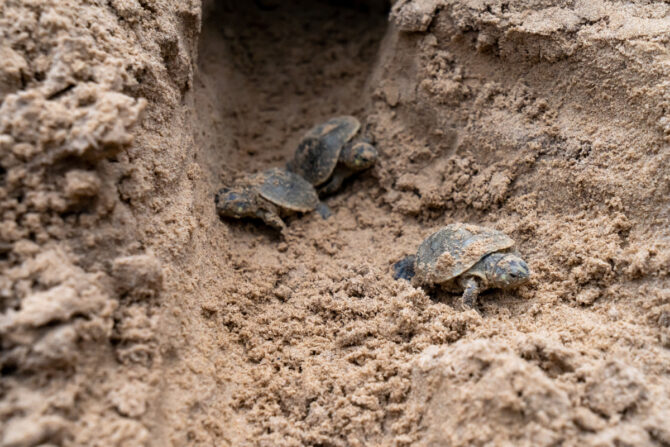
With the fish, frogs, turtles, and fruit trees all in the same location the ponds will become centers of activity. As noted earlier, there are many additional efficiencies gained through these integrated systems like using the muck removed from the bottom of the ponds as part of their maintenance as a fertilizer for the nitrogen poor-soils of the Amazon.
Activities:
Training: The first step for a successful project and to avoid the prior pitfalls is to invest heavily in training the Matsés to become experts in the construction and maintenance of integrated aquaculture systems. To integrate the Matsés’ extraordinary knowledge of the landscape and farming with best practices in the current science of aquaculture we launched the project with an intensive two-month training class led by a senior engineer from Iquitos and assisted by a recent graduate and junior engineer who is Matsés. The junior engineer helped with translating Spanish to Matsés and to make sure that the lessons were understood by all the class participants. Site selection is key for a successful fish farm, so the first portion of the class was dedicated to geomorphological properties and particularly hydrology. No amount of tamping can seal a pond with sandy soil, so they learned to identify areas with sufficient clay to hold the water. Placing a fishpond in a ravine would cause it to wash-out no matter how thick the dike, so they learned to balance the advantages of low-lying areas with being able to construct a dike sufficient to hold the water. During the class they built the first two fishponds, as hands-on is the best, but there were also important lessons that required some class work. Many ponds in the region fail because they do not calculate the ratio of dike height and width to the volume of water it will hold. Another important classroom topic was understanding the application of fertilizers to the water to establish a healthy environment for the fish. One skill that must be learned from experience is digging the well that will feed the pond. Once the first two fish-farms were completed, including the tree planting around the ponds, the newly trained individuals all worked together to build the third pond. This way they could reference each other and understand each other’s strengths and limitations. After this third pond was built, we all agreed that they could split up and we could build multiple ponds simultaneously. The Matsés who undertook this training trained others in each community, and so forth so knowledge and technical skills are widely disseminated.

Construction: As one can imagine, the logistical challenges were multifold. One was the transport of materials from Iquitos to the Matsés territories, especially the 6-meter-long PVC tubes. We sent the first load of materials for the training course by small plane. To fit the tubes, we had to cut them into three pieces and buy couplings so that the tubes could be rejoined on site. The hundreds of nylon sacks, wheelbarrows, and heavy tools meant that the shipment had to go on different planes chartered by three different agencies. We followed up with a truckload of supplies by ferry boat, but this was also difficult because there were no ferries (lanchas) with service from Iquitos all the way to Colonia Angamos (6-8 days journey). We found a ferry service to Islandia (another frontier river town in Peru) and then had to transship in Islandia for Angamos.
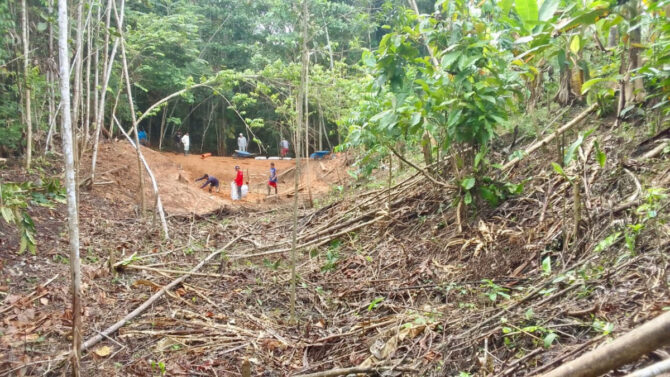
Construction of a dike ©Acaté
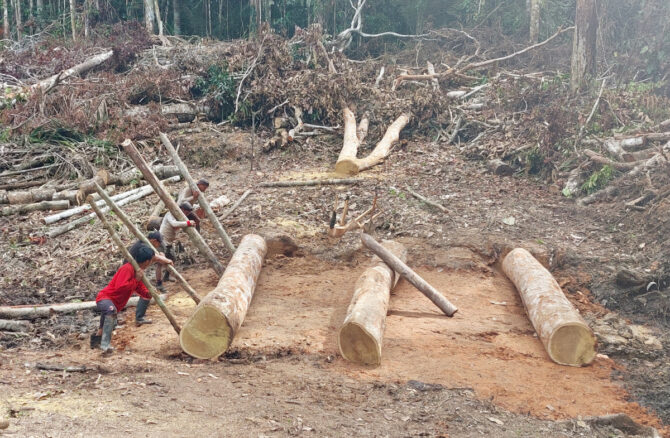
The jungle equivalent of a steam roller for leveling surfaces, tamping and removing organic matter.©Acaté
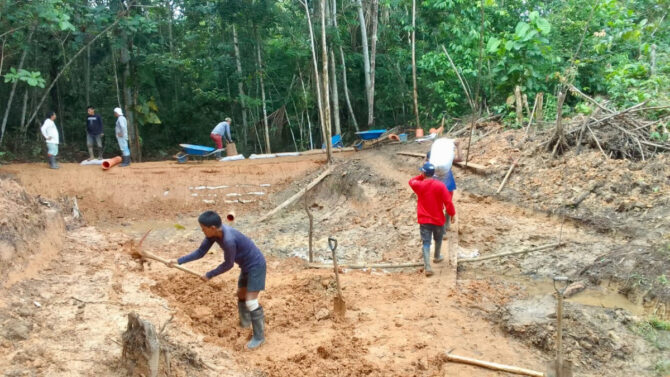
The construction of an aquaculture site is intensive work in which the community comes together to help out.©Acaté


Constructing a diversion channel©Acaté
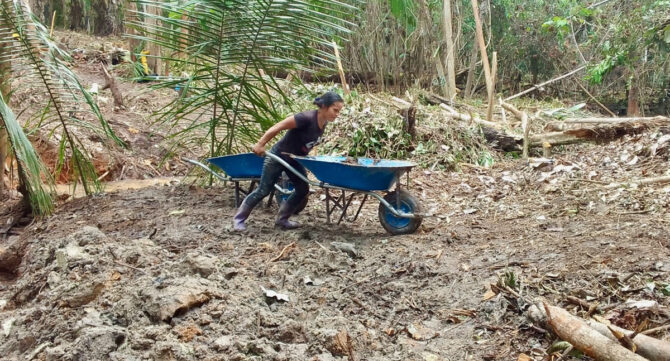
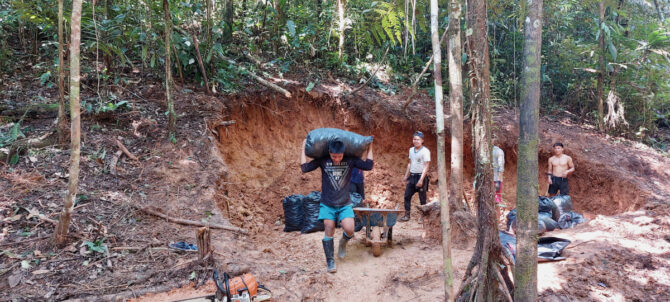
Each sack, when filled with clay, weighs about 70 kilos. To reinforce each dike, the Matsés fill and position between 200 to 400 of these sacks.©Acaté
After selecting the right site based on the geomorphology, the next step is digging out and tamping the pond. The infiltration rate and water supply also must be balanced, but with good clay and proper tamping (packing down) the infiltration should be close to zero. It is important to remove organic material as leaving it will reduce the oxygen levels as it decomposes. There are also predatory insect larvae that can decimate the fish fry, but treatment of the clay with calcium carbonate helps seal the pond and remove the larvae. One factor often overlooked is the phytoplankton populations in the pond, this is essential for both feeding the fish and for oxygen production. We added a well-balanced NPK (nitrogen, phosphorus, potassium) fertilizer to bootstrap the plankton population in the new ponds. Building the right size dike to hold the water accounting for natural compaction is critical to avoid overtopping or even dike collapse. The ponds are fed by wells, the surface water in the Amazon is shallow, so the wells can be dug with pics and shovels. The other important infrastructure is the diversion channel used to drain water away from the construction and to drain the pond in the future when necessary.
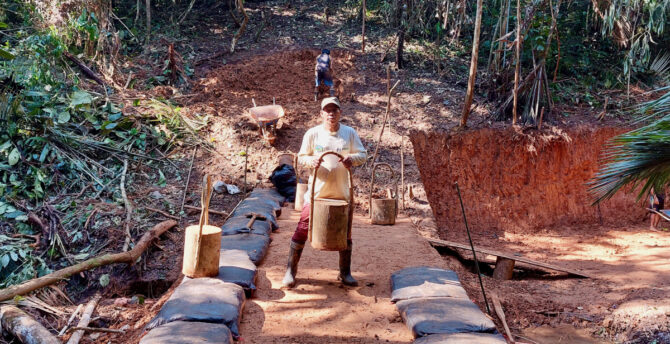
To tamper the clay, the Matsés designed and constructed their own tampers from forest materials.©Acaté
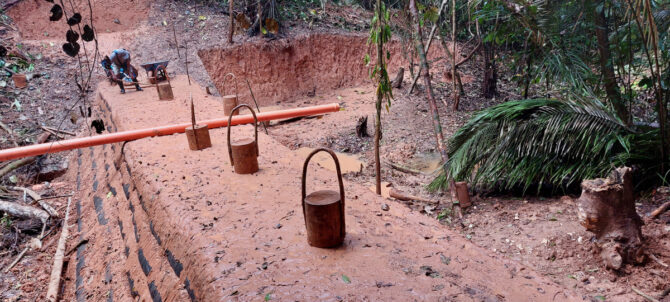
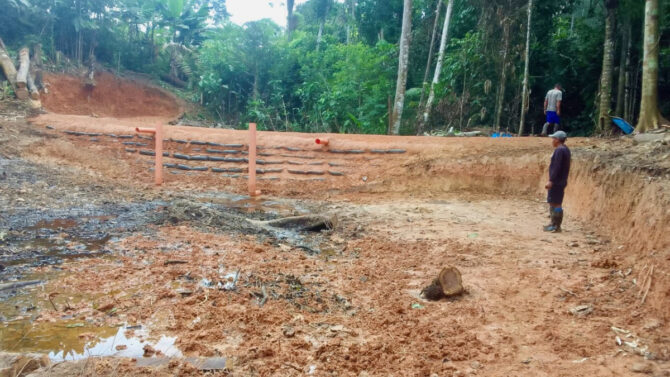
Once the pond and dike are complete the dike is planted with grass to avoid erosion and the trees that will eventually feed the fish (and children) are planted. The trees serve many uses, from frog habitat to providing shade to cool the water for the fish. The trees include staple crops like sweet bananas and plantains, fruit trees such as Pijuayo (Bactris gasipaes), Macambo (Theobroma bicolor), Annona (Annona muricata), Guava (Psidium guajava), and Gauba (Ingus edulus). The Matsés are planting medicinal plants as well; their knowledge exceeds 2000 plants.
In one of the most distal villages, very far upstream, where the stream is small and fishing opportunities are limited, the community joined together to construct a large fishpond. The dike is a full 6 meters thick and supports a pond that is 4,200 square meters in area. We are very pleased that the ponds are all holding water and we even had an enormous storm with flash flooding that put the ponds to the test. We are now in the dry season and thus far all the ponds are holding up very well.

Supplying fish: Stocking the ponds has been challenging due to the remoteness of the sites and will involve a combination of different short term and long term strategies. Firstly, the fish are largely sourced regionally from Iquitos and flow by small plane to Angamos, the gateway to the Matsés communities. The fry can survive in the transport boxes for up to 24 hrs and must be transported from the breeding facility to the local airport or Peruvian Air Force. Once there, they are required to pass a sanitary inspection to ensure they do not carry any pathogens that could endanger wild populations. The wildlife authorities must be notified and then they have to issue the certificate, which can take time. The flights involving small civilian or Air Force planes also face the risk of delays due to rains muddying the grass landing strip. Once the fish reach Angamos, then they have to go upriver to the nearest pond so they can recover for the rest of the journey.
For the first farms, the Matsés chose to stock with gamitana (Colossoma macropomum), also known as black pacu. This species is widely used in commercial aquaculture in the Peruvian Amazon due to its large size and delicious flesh. A relative of piranha, for which the juveniles bear a close resemblance and are often confused, gamitana has the additional advantages of being primarily vegetarian (unlike its cousin), disease resistant, and can thrive in low oxygen waters. The Matsés plan to add in boquichico (Prochilodus nigricans) and pacu (Piaractus brachypomus) as the aquaculture sites mature.
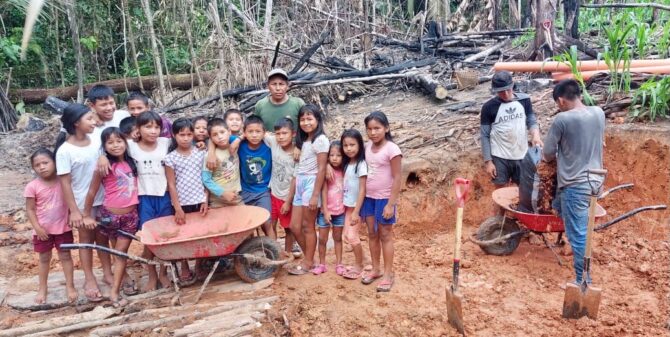
Women’s association: Women are underrepresented in Matsés tribal leadership and women’s issues are too often de-emphasized during meetings. For this initiative, we worked with Matsés to provide support for the development of a Matsés Women’s Association, the first in Matsés’ history and a significant step for their representation and leadership. The approach that the Matsés are implementing is to build this association is to develop it on the community level, one by one methodically and organically, rather than taking a top-down approach. Each village elects a four member women’s board. The formation of the women’s associations in each village is a key step towards food security and economic development. The women’s associations will further amplify the voices of women both within the villages and on the territory-wide basis. This exciting and important development of newly formed women’s associations, to build on the governance projects, will be reported on further in an upcoming field report.
Next steps
As of writing, over this year, 12 large integrated aquaculture sites have been built in 7 Matsés communities, with 8 more in active construction! Additional sites planned for later in the year with the start of the rainy season. We learned that long-term planning and strategic scheduling are important due to the seasonal weather: the most distant villages are hard to reach during the dry season because the narrow streams run shallow and obstructed by partially submerged logs, so materials are best transported during the rainy season. The rainy season, however, is not ideal for digging fishponds because of the mud. With this in mind, we will be able to work even more efficiently during the next year.
After the introduction of fry, the Matsés are monitoring the development of the fish. The goal of the project, with sufficient funding, is to ultimately set up a breeding facility for the Matsés to supply fry to each pond on a bi-annual basis.
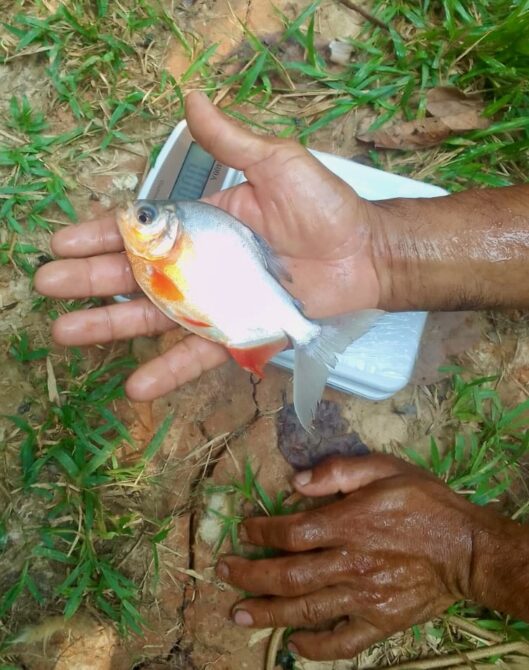
The Matsés in each community are monitoring biometrics of fish development in the aquaculture sites. Compare for scale to the gamitana fry in the image earlier in the report. ©Acaté
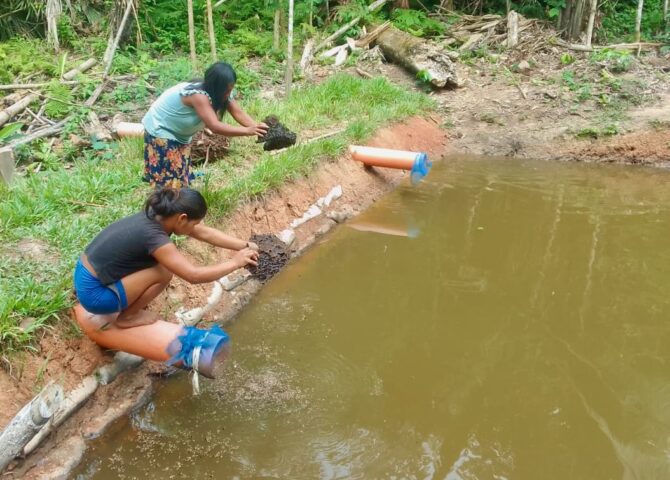
Matsés women innovating through feeding the fish by shaking out ant and termite nests which abound in the forests as a substitute for commercial fish food.©Acaté
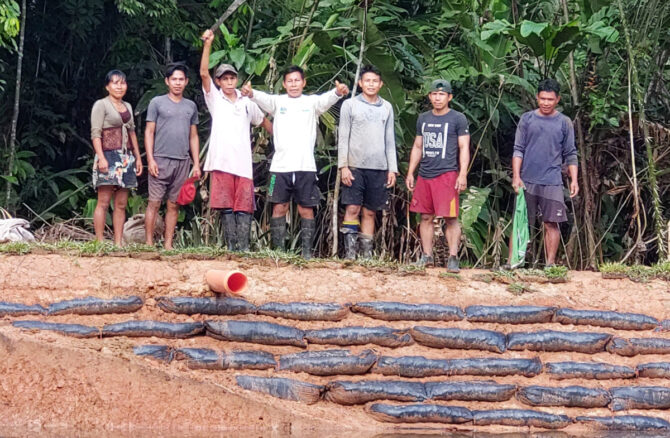
The Matsés communities are unified in the success of this initiative and looking forward to the next stages!©Acaté
On behalf of our organization and indigenous partners, we express our deep gratitude to our supporters for their partnership and generosity which permitted the Matsés to realize the launch of this federation project that is so important to the food security, conservation, nutrition, and economic development of Matsés communities.
If you missed it, take a look at our January 2023 field report on the community-based initiative in partnership with Acaté to protect uncontacted tribal groups in isolation and endangered river turtles!

Also, take a look at our field report from our initiative with the Matsés to support bilingual education and intergenerational transfer of ecological knowledge. In this update Dr. David Fleck reports on the development of three new interactive cellular phone apps!
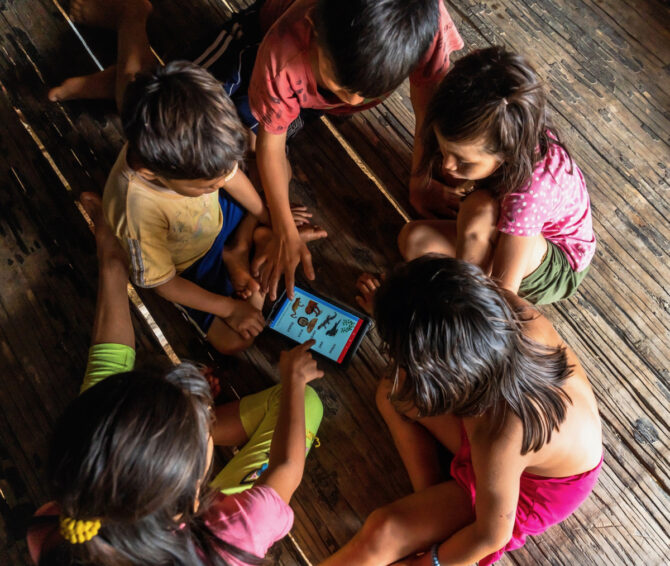
Acaté Amazon Conservation is a non-profit organization based in the United States and Perú that operates in a true and transparent partnership with the Matsés people of the Peruvian Amazon to maintain their self-sufficiency and way of life. The Matsés safeguard a critical conservation corridor and shield some of the last remaining uncontacted tribes in isolation from unwanted encroachment from the outside world. Acaté works to protect their forests and way of life through supporting on-the-ground initiatives that are led by the Matsés indigenous people.
Operating on the frontlines of conservation, Acaté’s initiatives over the past decade have included the first indigenous medicine encyclopedia as well as projects with original methodology in sustainable economic development, traditional medicine, medicinal agroforestry, nutritional diversity, regenerative agriculture, biodiversity inventory, education, native language literacy, participatory mapping, and protection of uncontacted tribal groups in isolation. All of our initiatives are developed with, led and implemented by the Matsés indigenous people. Donations are tax-deductible and go directly to fund these on-the-ground initiatives that operate with unparalleled transparency.
2023 is the 10th year anniversary of the launch of Acaté. In recognition of this milestone, we reflect on our work over the past decade and present our vision for the future of the organization. Read more here in this retrospective
All content and images copyright 2023 Acaté
